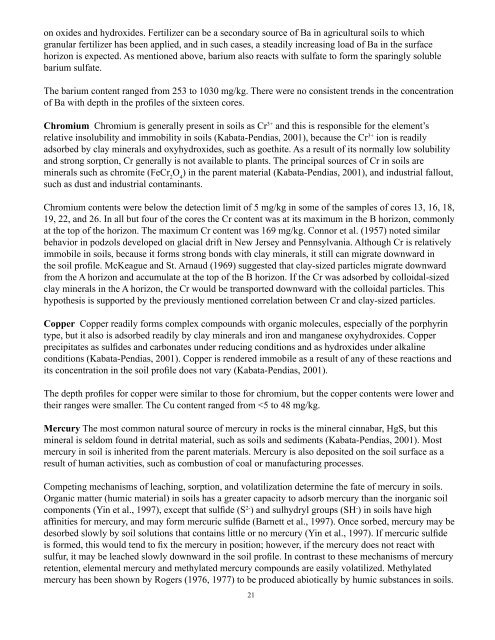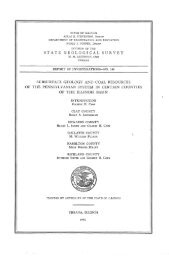in the clay-size fraction (Lindsay et al., 1989). Phosphorus-containing fertilizers are the most commonsource <strong>of</strong> phosphorus in agricultural and residential soils.The P 2O 5content in the cores generally decreased or remained rel<strong>at</strong>ively constant with depth. Where theP 2O 5content <strong>of</strong> the uppermost sample or two was much higher than the lower samples, there might havebeen a recent applic<strong>at</strong>ion <strong>of</strong> P-containing fertilizer.Manganese The principal source minerals for manganese in soils are amphiboles, pyroxene, biotite, andrhodonite (MnSiO 3) (Sparks, 1995). Although manganese occurs in the bulk <strong>of</strong> the soil as co<strong>at</strong>ings onother minerals (Kab<strong>at</strong>a-Pendias, 2001), it is also commonly found concentr<strong>at</strong>ed in nodules (concretions)accompanied <strong>by</strong> iron. These nodules seem to form in soil horizons th<strong>at</strong> periodically become w<strong>at</strong>erloggedso th<strong>at</strong> reducing conditions prevail, and the soil then dries, restoring oxidizing conditions (McKenzie,1989). In some soils a microscopic layered structure <strong>of</strong> altern<strong>at</strong>ing bands <strong>of</strong> iron-rich and manganeserichm<strong>at</strong>erial have been observed (McKenzie, 1989). However, the lack <strong>of</strong> correl<strong>at</strong>ion between MnO 2andFe 2O 3in the samples from these cores suggests no such intim<strong>at</strong>e associ<strong>at</strong>ion.In most <strong>of</strong> the cores the MnO 2content generally decreased with depth. One possible reason for this isth<strong>at</strong> manganese is sensitive to oxid<strong>at</strong>ion and reduction. Oxidized species, such as MnO 2, precipit<strong>at</strong>ewhere oxygen is readily available, as it normally would be near the surface <strong>of</strong> the soil, and decrease incontent with depth. The solubility <strong>of</strong> manganese increases as the pH and Eh (the oxid<strong>at</strong>ion-reductionpotential) decrease (the soil becomes more acidic and less oxidizing) (Lindsay, 1979). Under conditions <strong>of</strong>increasing acidity and decreasing oxid<strong>at</strong>ion potential, manganese would be somewh<strong>at</strong> easily leached.In a few cores (12, 14, 15, 16, and 18), however, the MnO 2content increased immedi<strong>at</strong>ely below thesurface to a depth <strong>of</strong> 1 to 2 feet, then decreased, and in other cores (12, 14, and 16) the behavior <strong>of</strong>manganese was opposite to th<strong>at</strong> described above. Possibly in these cores the Mn was present in colloidalsizedparticles th<strong>at</strong> migr<strong>at</strong>ed downward from the surface before becoming lodged.Sulfur The probable source <strong>of</strong> sulfur in these soils was the oxid<strong>at</strong>ion <strong>of</strong> the minerals pyrite and marcasite(they have the same chemical composition, FeS 2). Pyrite in <strong>Illinois</strong> soils was oxidized long ago, andthe S now is in the form <strong>of</strong> sulf<strong>at</strong>e, as in gypsum, or as organic sulfur compounds. Biological activity isresponsible for producing organic sulfur compounds (Stevenson, 1964).The content <strong>of</strong> SO 3in the sixteen cores was either below (cores <strong>11</strong> and 12) or near the analytical detectionlimit. The SO 3content was uniform both with depth and from core to core. Sulf<strong>at</strong>e forms compounds <strong>of</strong>low solubility with both barium and strontium.Secondary sources <strong>of</strong> S are fertilizers and, perhaps more importantly, fallout <strong>of</strong> particles from emissionsgener<strong>at</strong>ed <strong>by</strong> coal-fired power plants (Hoeft, 1986). As clean-air legisl<strong>at</strong>ion has increasingly forced powerplants to reduce the concentr<strong>at</strong>ion <strong>of</strong> S in their flue gases, fertilizer will likely become a more importantsource <strong>of</strong> S for growing crops. Prior to enactment <strong>of</strong> clean-air legisl<strong>at</strong>ion much <strong>of</strong> the crops’ need for Swas s<strong>at</strong>isfied <strong>by</strong> rainfall th<strong>at</strong> transported sulfur dioxide from the <strong>at</strong>mosphere to the soil (Hoeft, 1986).Barium Micas and feldspars are sources <strong>of</strong> barium in soils. These minerals contain potassium whichis commonly replaced <strong>by</strong> barium, because <strong>of</strong> the similar size <strong>of</strong> the two <strong>at</strong>oms (Kab<strong>at</strong>a-Pendias, 2001).Barium is strongly adsorbed on clay minerals in soils and, therefore, is not very mobile. Barium has beenfound in soils as barite (BaSO 4,Allen and Hajek, 1989) and hollandite [Ba(Mn 4+ ,Mn 2+ ) 8O 16, McKenzie,1989]. Barium also is concentr<strong>at</strong>ed in manganese and phosphorus concretions, and is specifically adsorbed20
on oxides and hydroxides. Fertilizer can be a secondary source <strong>of</strong> Ba in agricultural soils to whichgranular fertilizer has been applied, and in such cases, a steadily increasing load <strong>of</strong> Ba in the surfacehorizon is expected. As mentioned above, barium also reacts with sulf<strong>at</strong>e to form the sparingly solublebarium sulf<strong>at</strong>e.The barium content ranged from 253 to 1030 mg/kg. There were no consistent trends in the concentr<strong>at</strong>ion<strong>of</strong> Ba with depth in the pr<strong>of</strong>iles <strong>of</strong> the sixteen cores.Chromium Chromium is generally present in soils as Cr 3+ and this is responsible for the element’srel<strong>at</strong>ive insolubility and immobility in soils (Kab<strong>at</strong>a-Pendias, 2001), because the Cr 3+ ion is readilyadsorbed <strong>by</strong> clay minerals and oxyhydroxides, such as goethite. As a result <strong>of</strong> its normally low solubilityand strong sorption, Cr generally is not available to plants. The principal sources <strong>of</strong> Cr in soils areminerals such as chromite (FeCr 2O 4) in the parent m<strong>at</strong>erial (Kab<strong>at</strong>a-Pendias, 2001), and industrial fallout,such as dust and industrial contaminants.Chromium contents were below the detection limit <strong>of</strong> 5 mg/kg in some <strong>of</strong> the samples <strong>of</strong> cores 13, 16, 18,19, 22, and <strong>26</strong>. In all but four <strong>of</strong> the cores the Cr content was <strong>at</strong> its maximum in the B horizon, commonly<strong>at</strong> the top <strong>of</strong> the horizon. The maximum Cr content was 169 mg/kg. Connor et al. (1957) noted similarbehavior in podzols developed on glacial drift in New Jersey and Pennsylvania. Although Cr is rel<strong>at</strong>ivelyimmobile in soils, because it forms strong bonds with clay minerals, it still can migr<strong>at</strong>e downward inthe soil pr<strong>of</strong>ile. McKeague and St. Arnaud (1969) suggested th<strong>at</strong> clay-sized particles migr<strong>at</strong>e downwardfrom the A horizon and accumul<strong>at</strong>e <strong>at</strong> the top <strong>of</strong> the B horizon. If the Cr was adsorbed <strong>by</strong> colloidal-sizedclay minerals in the A horizon, the Cr would be transported downward with the colloidal particles. Thishypothesis is supported <strong>by</strong> the previously mentioned correl<strong>at</strong>ion between Cr and clay-sized particles.Copper Copper readily forms complex compounds with organic molecules, especially <strong>of</strong> the porphyrintype, but it also is adsorbed readily <strong>by</strong> clay minerals and iron and manganese oxyhydroxides. Copperprecipit<strong>at</strong>es as sulfides and carbon<strong>at</strong>es under reducing conditions and as hydroxides under alkalineconditions (Kab<strong>at</strong>a-Pendias, 2001). Copper is rendered immobile as a result <strong>of</strong> any <strong>of</strong> these reactions andits concentr<strong>at</strong>ion in the soil pr<strong>of</strong>ile does not vary (Kab<strong>at</strong>a-Pendias, 2001).The depth pr<strong>of</strong>iles for copper were similar to those for chromium, but the copper contents were lower andtheir ranges were smaller. The Cu content ranged from
- Page 1 and 2: A Progress Report on the Descriptio
- Page 3 and 4: INTRODUCTIONThe Illinois State Geol
- Page 5 and 6: As continental glaciers advanced in
- Page 7 and 8: In areas where the glacial sediment
- Page 9 and 10: the boundary between them. Where su
- Page 11 and 12: Occlusion refers to the physical en
- Page 13 and 14: tungsten carbide grinding capsule t
- Page 15 and 16: RESULTS AND DISCUSSIONSampling Plan
- Page 17 and 18: increases also. If the correlation
- Page 19 and 20: CO 2 gas= CO 2 aqCO 2 aq+ H 2O = H
- Page 21: Potassium Typically, potassium occu
- Page 25 and 26: For most cores, the Rb content was
- Page 27 and 28: Brady, N. C. and R. R. Weil, 1999,
- Page 29 and 30: Killey, M. M., 1998, Illinois’ Ic
- Page 31 and 32: Table 1. Core number, county name,
- Page 33 and 34: Table 3. Texture of samples from co
- Page 35 and 36: Table 9. Texture of samples from co
- Page 37 and 38: Table 15. Texture of samples from c
- Page 39 and 40: Table 19. Soil texture, soil type,
- Page 41 and 42: Table 20 continued. Correlation coe
- Page 43 and 44: Table 21. Elemental composition of
- Page 45 and 46: Table 23. Elemental composition of
- Page 47 and 48: Table 25. Elemental composition of
- Page 49 and 50: Table 27. Elemental composition of
- Page 51 and 52: Table 29. Elemental composition of
- Page 53 and 54: Table 31. Elemental composition of
- Page 55 and 56: Table 33. Elemental composition of
- Page 57 and 58: Table 35. Elemental composition of
- Page 59 and 60: Table 37. Means and ranges of eleme
- Page 61 and 62: Sample locationFigure 2 Sample loca
- Page 63 and 64: Figure 461
- Page 65 and 66: Figure 6.63
- Page 67 and 68: Figure 8.65
- Page 69 and 70: Figure 10.67
- Page 71 and 72: Figure 12.69
- Page 73 and 74:
Figure 14.71
- Page 75 and 76:
Figure 16.73
- Page 77 and 78:
Figure 18.75
- Page 79 and 80:
Figure 20.77
- Page 81 and 82:
Figure 22.79
- Page 83 and 84:
Figure 24.81
- Page 85 and 86:
Figure 26.83
- Page 87 and 88:
Figure 28.85
- Page 89 and 90:
Figure 31.87
- Page 91 and 92:
Figure 33.89
- Page 93 and 94:
Figure 35.91
- Page 95:
Figure 37.93
















